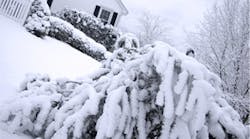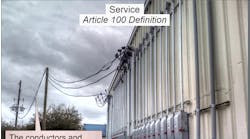Snowmelt systems are installed in many building applications across differing climatic regions. Areas are classified by heat trace experts according to the snow load accumulated within each region during a typical winter season. Although this can help in the specification of a snowmelt system, the viability of any system still requires an operational assessment after installation. You can use infrared (IR) imaging to quickly and efficiently determine the capability of snowmelt systems for roof, valley, gutters, and downspouts while in real-time operation and for other heat trace cable systems, such as:
-
Pavement and walkway snowmelt systems
-
Radiant floor heating systems
-
Frost heave prevention systems
-
Frost-free pipe systems
Heat trace cables produce a thermal signature that an IR camera can easily detect. If a snowmelt electrical circuit is operating properly, it's simply a matter of looking at the camera's thermographic image and temperature readings. Typically, you perform these evaluations to verify proper operation of the system.
Heat trace cable operation
A basic roof snowmelt system is usually made up of heat trace cabling that provides a self-regulating, low-wattage heat source through a parallel circuit. Manufacturers design cables for these applications specifically for roof and gutter applications with a durable exterior UV-resistant covering made to withstand harsh environments (click here to see Fig. 1).
As snow melts away from the cable system, it is exposed to air and the temperature rises around the cable, thereby causing its energy output to decrease. This is an economical design for controlling energy consumption while delivering the necessary snowmelt performance; however, it does not help troubleshoot non-operational cable areas or systems.
Because ambient temperature is an important variable effecting heat trace cable output, you must consider it carefully when performing electrical calculations and evaluating heat trace operational capability. This is particularly important when verifying operation of a new installation, which is usually done in the absence of snow.
IR thermography evaluations
After installation, perform initial testing to establish baseline data for the normal operating range. Next, record subsequent measurements periodically and compare them to baseline data to identify potential malfunctions. Maintaining the system per manufacturer's recommendations requires an ongoing regimen of regular operational testing, which should include the recording of measurement data/ pertinent events (click here to see Fig. 2). Figure 3 shows a digital photo and corresponding thermogram of a building with an operational heat trace system along the valleys down to the roof ice melt system.
An evaluation of overall system efficiency — or efficiency of a specific area — becomes a moving target due to all the uncontrolled variables associated with an exterior environment (ambient temperature, snow, ice, wind, etc.). Nevertheless, an evaluation with IR imaging can determine if the heated areas are sufficient to maintain ice and snow thaw in a way that meets the designer's criteria. The thermograms and associated temperature data are the basis for the type of graph shown in Fig. 2. Camera manufacturers supply software for creating such graphs, outputting data to spreadsheet programs, and generating reports.
A high-resolution IR camera is recommended for this type of work, particularly when there is a relatively long distance between the camera and the heat trace system. For shorter distances, or with cameras that have long focal length lenses available, a lower resolution camera may be suitable. Whatever camera is used, it's most important that all data for temperature versus time trending be obtained from the exact location where the camera was originally situated for baseline data collection.
System testing
At first glance, evaluating a snow/ice melt system can seem daunting without a detailed drawing of its layout, some baseline test data, and a history of its installation and maintenance. A properly designed snowmelt system will have multiple electrical circuits. System testing and evaluation must answer the following questions for the client:
-
Is the overall system operational?
-
Are specific parts non-functional?
-
Are there any circuit or cable defects within the installed areas?
-
Is the system design sufficient for the surface area to which it is applied?
When conventional evaluation methods are employed, you would typically have to disassemble the circuit from the panel circuit breaker and conduct a series of electrical measurements. First, perform a resistance test of the system's insulation to look for shorts. Next, take resistance readings of the circuit itself and determine its overall length. Once you document these tests, reconnect the circuit and take current readings to note inrush startup current and steady-state current after the load balances out.
You should test each individual snowmelt circuit this way, with voltages, currents, and resistances documented. Next, it's time to calculate approximate heat trace cable lengths based on the documented readings. To calculate an “effective cable length” number, you must factor in the atmospheric temperature (at the time of making all the tests) — and possibly other parameters. Compare this calculated length to the design drawing length of cable to produce a delta reading between the two numbers. The purpose of this comparison is to find out if you are “missing” some cable length, which could indicate part of the system is not working. Finally, you would produce a roof-mapping diagram for every structure and calculate/document circuit information to generate a report on all of the circuits.
However, none of the mapping work and efforts would provide any definitive answers as to the locations of failures. Without a “picture” of the problem, it would be difficult to provide a repair plan. None of the calculations just described could tell you effectively the precise location of the system malfunction, or where it is not working at all. In most cases, this exercise would lead to more questions than answers.
You can use IR imaging to evaluate heat trace cables in any application. It's a safe and efficient way to produce a portrait in an instant of all pertinent surface areas where heat trace is installed.
Christoferson is a Level I thermographer and electrical consultant for Madsen, Kneppers & Associates, Inc., headquartered in Denver. He can be reached at [email protected].
Sidebar: Challenging Evaluation
Madsen, Kneppers & Associates was called on recently to evaluate a snowmelt system that a building owner believed was not working properly. The system is installed on a multi-story structure in a Class 1 alpine setting (click here to see Fig. A).
The building has a standing seam metal roof that is fitted with a roof ice melt system using heat trace cable. This system is designed to minimize the formation of icicles and ice dams at the perimeter edges of the building where water runoff is most likely to occur. Heat trace cable also is installed within the eave gutters and downspouts to prevent ice buildup inside. There are multiple levels to the tiered roof structure in addition to multiple dormers. The ground level roofs cover mostly walkways and egress points along the perimeter of the building. The roof slope angles at all elevations are 12-to-12 (50%) or greater for hydrokinetic (water-shedding) purposes. The roof design also includes many areas that contain valley assemblies between the dormers, which required different versions of the snowmelt system design.
In this particular installation, the heat trace cable is totally hidden from view (Fig. B) and protected by a cover panel. From an evaluation perspective, the disadvantage to this type of design is significant difficulty and intensive labor required to inspect the system using conventional methods described in the main text of the article.
We opted to use IR imaging with a handheld camera to characterize the operation of each circuit by location. The handheld IR camera gave us the ability to visualize the building from many different angles. We performed some close-up imaging, but found that an overall perspective from roof level provided more definitive images. The lightweight handheld IR camera was easy to transport and operate when working from rooftops.
In our evaluation of the building in question, we focused predominantly on the exterior components. Our procedure involved the following activities in surveying the snowmelt circuitry:
-
Documenting the time, date, humidity, background ambient temperature, and the air temperature at the time of testing.
-
Documenting the camera settings to help interpret results.
-
Producing digital photo images of the snowmelt circuit locations.
-
Producing an infrared image of the same locations for side-by-side comparison; each image provides a temperature readout that shows if the heat trace cable is working.
-
Documenting the feeder circuit number and panel number noted in the junction box.
All of this information was inserted into the final thermographic inspection report for each location evaluated. Figure C shows typical digital/IR camera images for a specific circuit location. Note the scale on the right side of the thermogram; it shows that the temperature of the snowmelt circuit at the roof eave is above 60°F. Most of the remaining structure has temperatures between 43°F and 50°F (i.e., near the ambient temperature). The Table shows this as an average background temperature. The emittance setting is a camera configuration input required to ensure accurate temperature readings. Typically, this is obtained from published tables available for different types of materials.
The IR scan results for the building under study and its snowmelt circuits turned up some problem areas, but they didn't appear to be associated with design or installation. In some cases, the snowmelt circuitry had simply not been turned on at the electrical panels. The underlying problem was discovered to be a recent change in the maintenance organization, and the snowmelt system operating procedures had not been passed along to the new group.








